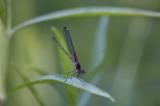 © Bruce McNitt/Panoramic Images (Virginia)
© Bruce McNitt/Panoramic Images (Virginia)

Conservation Overview of Virginia
They’re all around. Zagging over ponds, zigging around meadows, zipping up rivers. They come with many patterns and colors – dusted, striped, banded and blotched; reds, greens, grays, browns and neon blues. And their names are just as varied and colorful – saddlebags, snaketails, sprites, darners, amberwings and meadowhawks. Bug people call them odonata, or more casually, odonates. Normal people call them dragonflies and damselflies. About 200 species make Virginia home, possibly more than in any other state. This surprising diversity is really not so surprising when you consider two facts: dragonflies and damselflies, like most insects, are typically habitat specialists; and Virginia, from shining sea to purple mountains’ majesty, has an incredible diversity of habitats.
Spanning ten physiographic provinces, Virginia’s topography, geology, soils and climate vary significantly from east to west and south to north. The waters (so essential to the larval odonates) can be salty or fresh, hot or cold, brown or clear, violent or calm. The land can be flat or steep, barren or lush, forested or meadowed. This landscape diversity translates directly into biological diversity, including not only odonates but also other animals and plants. Indeed Virginia contains one of six hotspots for biological diversity and ranks third for the number of caves, and ranks 12th in the U.S. for the number of native plant and animal species. A handful of these are unique to Virginia. Among the state’s endemics are five vascular plants, two salamanders, three fishes and well over 100 invertebrates.
While much of Virginia’s species diversity is more or less evenly distributed – as is the case with Virginia’s odonates – there are a few areas where the rare species are concentrated. Among these biodiversity hotspots are the wind-tidal wetlands in the southeast, the fire-maintained pinelands of the southern coastal plain, the barrier islands along the Eastern Shore and the 4,000-foot plus peaks along the state’s western flank. However, the greatest concentration of rare species and unusual natural communities is in the far southwestern corner of the state. This is due in part to the limestone underlying much of the area, which supports rich forests, floristically diverse barrens and an abundance of caves with their own unique species. And there are southwest Virginia’s rivers and streams. The upper Clinch River supports more imperiled and vulnerable species of fishes (29 species) and mussels (35) than any other watershed in the U.S. The neighboring Powell River and North Fork Holston River watersheds also support a great diversity of aquatic species. (Powell – 35 mussel species, 29 fishes; NFH – 18 mussels, 17 fishes)
As the numbers of rare aquatic species in southwest Virginia’s waterways highlight, much of the state’s biological diversity faces an uncertain future. Statewide, the Virginia Department of Conservation and Recreation’s Natural Heritage Program ranks some 1,500 species of plants and animals as rare. This includes nearly a third of the state’s dragonflies and damselflies, and about a quarter of the vascular plant and vertebrate species. As Virginia’s human population grows by 89,000 or 14.4% per year (U.S. Census 1990 – 2000) (by xx per year), space for native species shrinks. Direct loss and fragmentation of habitat, largely due to conversion of open space for residential and commercial development, is the greatest threat to Virginia’s biodiversity. Add to this stiff competition from exotic species, diminished air quality from the combustion of fossil fuels, non-point source pollution of the waterways, climate change and associated sea level rise and the picture can look pretty gloomy.
Fortunately, Virginians are increasingly aware of these concerns and are undertaking numerous initiatives to protect open space, reduce pollution and preserve rare species habitat. Governor Tim Kaine has established a goal of permanently protecting 400,000 acres of open space during his administration. Several federal agencies, local governments and non-profit conservation organizations, as well as many private and corporate landowners, have pitched in to help Governor Kaine’s land conservation agencies –Virginia Outdoors Foundation, Department of Conservation and Recreation, Department of Game and Inland Fisheries, Department of Historic Resources, Department of Forestry and Department of Agriculture – achieve this goal. The Department of Conservation and Recreation’s Natural Heritage Program is focused especially on protecting habitat for rare species and significant natural communities. To date, the program manages a natural area preserve system comprised of 54 preserves, encompassing more than 45,000 acres and supporting over 500 mapped locations of rare plants, animals (including five odonates), significant natural communities and other important features of Virginia’s biodiversity.
Clearly…you needn’t have the compound eye of an odonate to see: our challenges to protecting Virginia’s biodiversity are as diverse as the life harbored there. From zipping dragonflies patrolling vast tidal marshes, to dainty emeralds lofting along cool quiet southern Appalachian headwater streams; from literally handfuls-left-in-the-world cave isopod populations to vulnerable birds on ephemeral shorelines of the eastern shore; from the last few Peter’s Mountain-mallows in the mountains to ancient cypress-tupelo swamps; there is a fabulous array of other species and communities in between, each silently requesting certain attributes that allow their persistence. And in the face of human demands on the lands they require, it will take a Herculean effort to keep them here. Luckily, there is no one better to make this conservation possible than the informed, educated, science-based, critically thinking, tool-equipped, collaborative and driven “us.”






